Whenever you heard the name Arkansas, the first thing that pops up in your mind is the Diamond mine, Wilderness, Mountains & River but the tree frog is there too which often goes missing from the list.
This vast land with rich animal life is the permanent home of 13 colorful tree frogs. And their numbers are increasing while most of them are listed as least concerned.
Knowing about the natural habitat, diet, size, sexual maturity, breeding season, mate calling sound, skin color, predator, and adaptation will give you an opening to a whole new dimension.
Without fiddling around let’s enjoy reading them one by one in the following part.
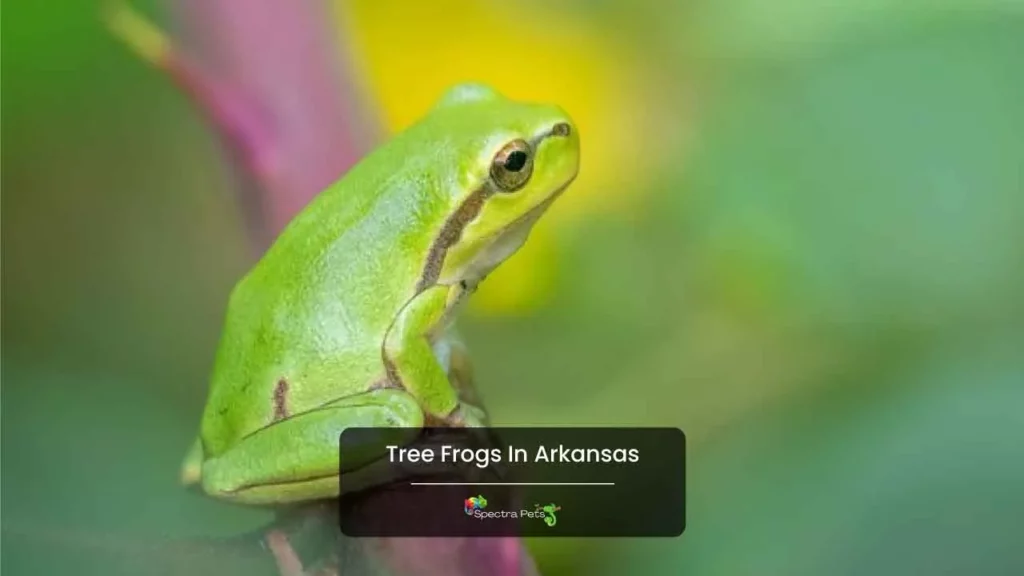
1. Upland chorus frog
This amazing creature belongs to many states of the USA which includes New Jersey, Florida, Alabama, and Pennsylvania. And these magnificent tree frog doesn’t grow much big and their size can vary from 0.72 to 1.5 inch.
In terms of sexual maturity, these species become mature within 1 year. It’s easy to find the uniqueness between males and females. The male is comparatively smaller and has a vocal sac on their throat. While the female is bigger and there is no vocal sec.
When it comes to the natural habitat, they pick places like marshes, swampy wetlands, grassy swale, close to ponds, marshes and woodland etc. Due to their nocturnal behavior, they are not seen in open areas.
The breeding season of this frog begins in November and lasts until march. The male frog produces a sound similar to the sound of someone running their fingertips on a plastic comb. By listening to the males’ call, female frogs rush to the breeding spots. When the males prepare themself for breeding, their throats turn into darker tunes.
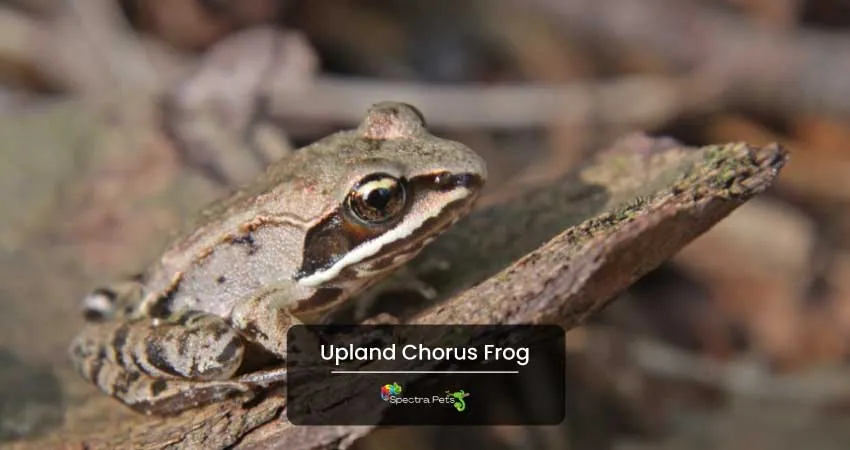
Besides, their successful breeding rate is only 17.2% and the female lays around 1000 eggs after a perfect lovemaking session.
Adding to that, their breeding spots include roadside ditches, shallow wetlands, temporary pools, grassy wetland flattered pastures, and agricultural fields.
You can see this tree frog in versatile colors like greenish-brown, reddish-brown, grayish-brown, etc. Plus, they have stripes on their back. As their population growth is quite good, this Hylidae member is listed as the least concerned frog.
Though they belong to the tree frog family, they spend most of their time on the ground under the leaves. Luckily their body color & stripe marks give them an immense advantage in hiding from predators like snakes, raccoons, and biggie frogs.
2. Spotted chorus frog
One of the soft & moist skin tree frogs is distributed over a huge part of Arkansas, Texas, Ohio, Wisconsin, Alabama, Tennessee, Pennsylvania, and Vermont, etc.
Plus, the average survival rate of this amphibian is around 2 years & they live on feeding versatile insects like beetles, crickets, plants, moths, flies, etc. As a result, they help the ecosystem to stay balanced from being overpopulated by insects.
During winter, these little buddies dig themselves under the ground and activate the hibernation mood. Their skin color can be olive green, gray, brown, or green shades. Similar to other tree frogs, females are heavier & bigger than males. The average growth length of the species can vary from 1.2-1.6″.
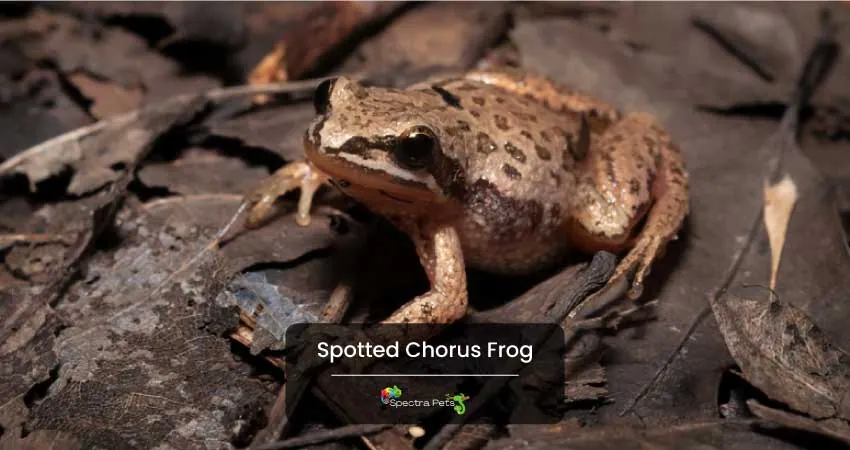
Speaking of their home, they prefer to stay in places like canals, prairies, meadows, grassland, etc. Their rank in the food chain of Arkansas makes them a desirable choice for water snakes, fish, salamanders, birds of prey, and garter snakes.
When the breeding season comes, they leave their solitary nature for a few months and many males get into large-size temporary pools, cattle tanks, or marshes. From there, they make a high-pitched call frequently to bring the female close to them. A few days after mating, the mommy frog will lay 1500 eggs on the surface water.
3. Boreal Chorus Frog
The next day’s tree frog in the least is the Boreal chorus frog which is pretty small in size around 1.5 inches in length. Like many other frogs, females are larger than their male counterparts. When it comes to skin color, you can see them in gray, brown, olive, and radish shades.
Due to their shy nature, it’s hard to see them in daylight. These creatures are very expert at hiding themselves in their habitat. Their nocturnal behavior pushes them to search for food in the nighttime.
Moreover, the natural habitat of this frog includes roadside ditches, moist meadows, agricultural land, mountain ponds, woodland ponds, etc. Despite being outstanding climbers, they spend a significant amount of time on the forest floor. The breeding season of this species remains from March-June.
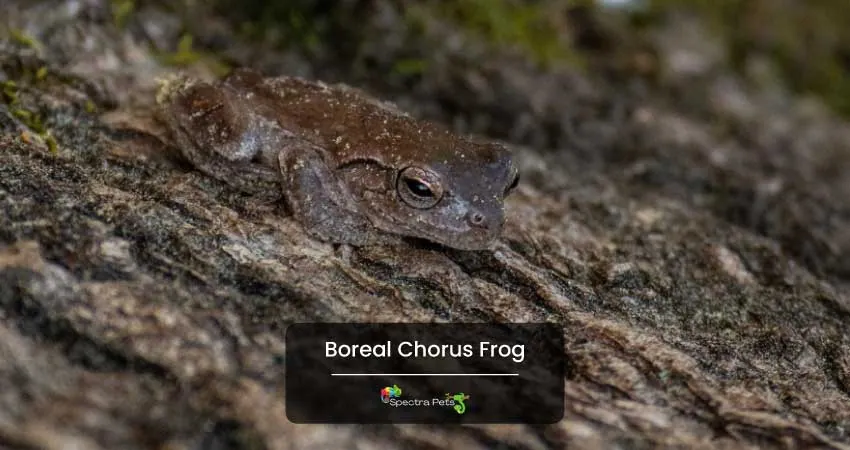
As they live in moist areas, high numbers of bugs are expected and they eat a lot of them like spiders, earthworms, mites, etc. Their favorite breeding spot is seasonal water pools, and the male calls out to the female to begin the reproduction journey. Adding to that, the most common time for calling is nigh-dawn.
This tree frog just loves leaving close to slow-water habitats like floods. It feels like roadside ditches, moist woodland, and lakes. Moreover, they are found in Arizona, Florida, Minnesota, Utah, Wisconsin, etc.
Besides, they are listed as the least concerned amphibians in the state. With the first footstep of winter, they enter into hibernation mode under thick vegetation or rocks.
Plus, the intelligent frog runs away from its predator successfully by climbing. When the predator is an aquatic animal, it will jump onto land as fast as possible. On the other hand, they will directly jump into the water & starts swimming to save themselves from terrestrial animals. Predators like raccoons, birds of prey, bigger frog, and crayfish hunt them and the ecosystem remains perfectly balanced.
Regarding lifespan, the average is 2 years, though some lucky ones survive more than 3 years in the wild.
Apart from the size, another big difference between males & females is the throat color. Usually, the male throat has green and yellow shades while the female has a cream-colored throat.
4. Strecker’s Chorus Frog
The most common dorsal color of this 2″ frog is gray, grayish brown, or greenish-brown. On the forehead, a triangle mark is seen on most of this species.
Moreover, the natural habitat of this species includes canals, sand prairies, drainage channels, cypress swamps, grassland, shady woods, etc.
One of the unique attributes of this species is they use the front leg to burrow under the ground. This crazy digger can go as deep as 0.3 to 2.62 feet underground. These rocky mountain lover frog elevation levels can vary from 2000 to 6500 ft from sea level.
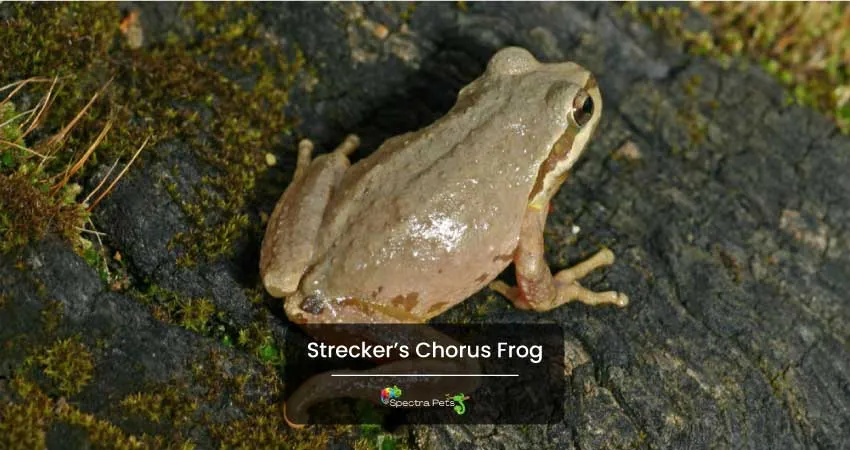
Thanks to their amazing capability to burrow under the soil that saves them from the potential predator and scorching heat of summer. Sadly, they are not good climbers as they don’t have sticky big-toe pads.
Speaking of the diet, this little carnivorous monster eats a huge amount of small arthropods and invertebrates. Predators like garter snakes, fish, raccoons, etc hunt them for a living.
These cute frogs are distributed in different states like Arkansas, Oklahoma, Texas, Louisiana, etc. Due to their steady population growth, they are marked as the least concerned frog.
Besides, the mating season of this species stays from November to March. The early spring rain gives them a boost for going to the breeding ground. And, they pick flooded fields, roadside ditches, cultivated fields, vernal pools, and fishless ponds as breeding sites.
When the breeding season rolls out, the male generates a high-pitched squeaky sound to grab the attention of the female. As soon as the mating is done, the female would lay close to 700 eggs on the aquatic plants. The most favorable condition for breeding is 40 degrees Fahrenheit.
Finally, about lifespan, this small critter has an average of 1.5 -2 years in the wild habitat.
5. Cajun chorus frog
Another big name in the tree frog family belongs to places like Arkansas, Mississippi, Texas, Louisiana, etc.
The breeding season of this wonderful species starts at the end of the winter & lasts until the beginning of spring. As the breeding season approaches, the male does not delay in calling his female partner from the late evening into the early morning. In simple terms, they don’t stop calling as long as the sky remains dark.
Plus, they engage in mating when the temperature stays 4 – 21 degree Celsius. And rainfall speeds up the mating process.
In addition to that, males select breeding spots as the shoreline of lakes, flooded fields, etc. The high trill sound doesn’t fail to attract the female. Native people of Arkansas can hear them calling from the breeding sites.
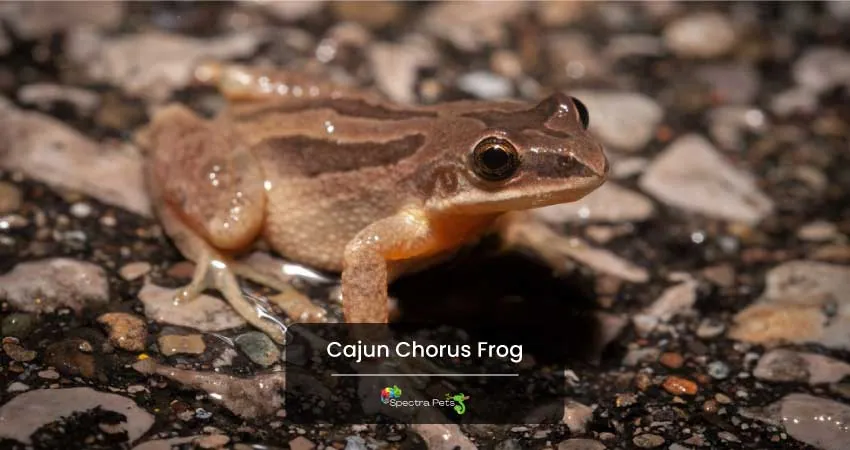
It’s not tough to tell the difference between males & females. Because the male cajun chorus frog has a vocal sac that expands when it makes the sound.
Plus, this species lives in versatile habitats like roadside ditches, shallow wetlands, marshes, swamps, etc. The local people of Arkansas will probably never encounter them in daylight even if they go to their habitat zone.
Moreover, this granular skin frog grows up to 1.24″ in size. And their average survival rate is 1 year. A small number can survive more than 3 years. Speaking of dorsal color, they can be found in brown or black shades with visible dark stripes on the back.
Despite being a tree frog, this cutie stays under a pile of leaves on the ground. Their favorite meal includes tiny insects such as ants, flies, and spiders. They add a great balance by feeding on a good percentage of insects around the year. And, they become food for higher-level predators like garter snakes, ribbon snakes, water snakes, turtles, etc.
6. Blanchard’s cricket frog
Blanchard’s cricket frog is a warty skin animal that can have versatile colors like green, brown, greenish tan, etc. This wonderful species can get up to 1.5″ large. The distribution of this amphibian is wide and found in Arkansas, Lowa, Texas, Minnesota, etc. It’s common for them to have black, yellow, orange, or red markings on the back.
Usually, a significant number of these frogs die right after the 4 months of their birth. Some lucky adult frogs that survive the freezing winter get at least 1- 2 years of lifespan in their natural habitat.
When the winter knocks at the door, these amphibians turn on their hibernation mode and hide in pond cracks or crayfish holes. Sadly around 5% of the frogs can see the next summer after winter.
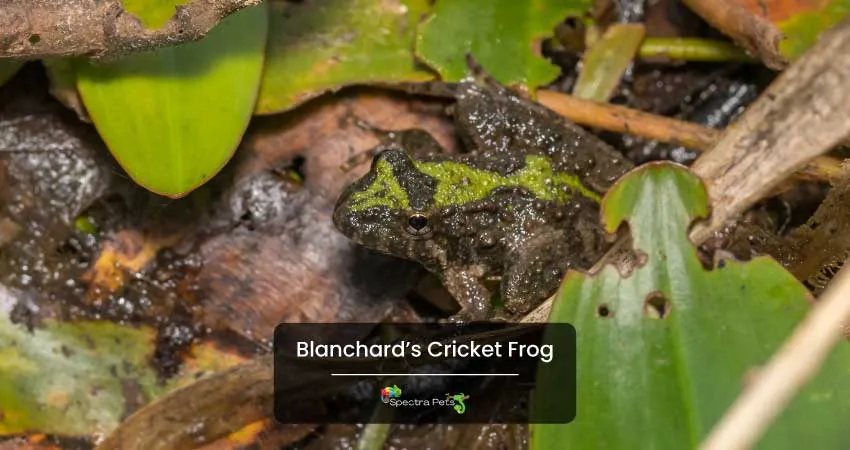
Speaking of natural habitats, they prefer slow-moving water bodies, shallow wetlands, ponds, mud flats, and marshes. Local people of Arkansas may see them roaming around in larger lakes or polluted sites.
During the daytime, they find comfort in hiding under rocks or tree logs. Their nocturnal instinct drives them to hunt when the night begins. The staple food of this little fella is moths, crickets, ants, flies, etc.
Plus, they are legendary swimmers which helps them to dodge their predators. And the webbed toe helps a lot to do that smoothly. The Dorsal color of this species itself acts as a camouflage, so the predators have a hard time hunting them down. Animals like raccoons, birds of prey, snakes, turtles, and larger fish are the predator of this tree frog.
While they hit sexual maturity at 1-year-old, their breeding season starts in May and ends in August. The seasonal rain fastened up their breeding process.
About the calling sound, the male species try to mesmerize the female with their metallic sound. As long as the breeding season remains, they will call at any time in 24 hours. One noticeable difference between male & female is that the male is smaller. And in breeding time, their throat turns darker while the female’s color remains the same.
7. Western Bird’s voiced tree frog
Native to states like Arkansas, Oklahoma, South Carolina, and Mississippi, this family has stable growth in its distribution range.
Plus, for their optimum body functions, they need to be in moisture-filled areas nearby water. Places like wooden swamps, flooded fields, and large creeks are their favorite home. Moreover, their bulging eyes are one of the prominent features of this species.
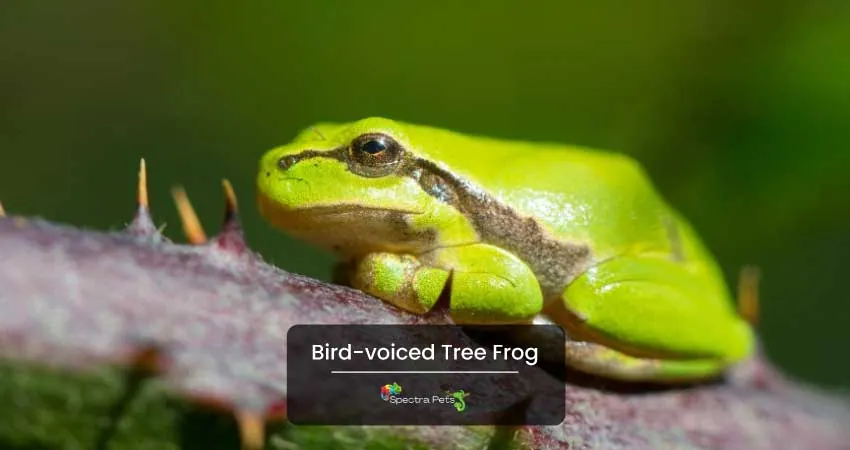
During the month of April-August, the male will make bird-like sounds to allure the female in the listening range. They repeat the sound at least 20 times a minute. Right after hearing the call, the female feels irresistible and joins their male partner in the breeding spot. Female frogs will lay eggs on submerged aquatic plants and the bottom or shallow pond.
In terms of size, they are mid-level size tree frogs that can grow up to 1.75″ in length. These frogs are blessed with the dorsal color-changing ability which gives them huge support in hiding in their habitat. Adding to that, their average life is around 4 years in the wild.
The tree frog name goes well with them as they are expert climbers and spend a significant time on trees and shrubs. The skin color of the little amphibian can be green, brown, or gray.
8. Squirrel tree frog
This amazing frog is found in many parts of the USA which includes Arkansas, Georgia, South Carolina, Florida, and Alabama, and they are very little in size around 1.5 but in terms of hunting, they are really expert. It can have a variety of colors, such as brown, yellowish, green, and tan. Adding to that they can also change their skin color which works as camouflage.
This species is an arboreal one so climbing on trees and vegetation is no big deal for them. Different types of mammals and bigger frogs usually hunt these little fellas.
Like other frogs, they have a very long mating period starting in March and ending in October. As soon as the meeting season begins, the male one generates a mating sound to attract the female into the breeding spots. One funny thing is that the calling sound of this species almost sounds like a squirrel’s sound. After half a second, you will hear the sounds repeating.
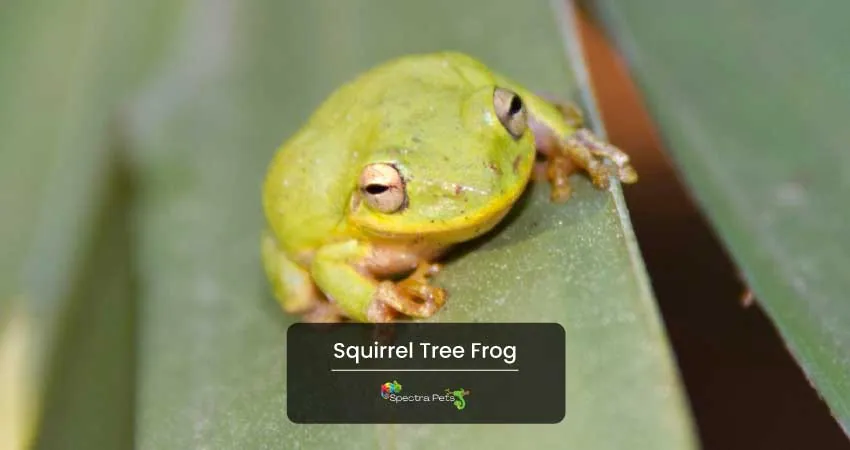
In urbanized areas of Arkansas, these frogs are mostly found under trees and shrubs. However, their natural habitat includes bottomlands, swamps, marshes, etc. And for breathing, they choose fishless ponds, roadside ditches, flooded fields, and marshes. For local people of Arkansas, it would not be a rare case to see the frog crossing the highway just after rain.
Speaking of the diet, this tiny frog enjoys spiders, termites, and mites.
Regarding lifespan, this frog gets around 10 years in the wild. During winter, these amphibians take shelter under loose berks and tree logs. Thanks to the hibernation ability of this species which helps them to survive the winter easily.
9. Green tree frog
Along with Arkansas, these frogs are found in other states such as Florida, Kentucky, Tennessee, Texas, Delaware, Missouri, etc.
The skin color of this beautiful frog can be greenish gray, dark olive, bright green, yellow-green, or reddish-brown. And the stomach is cream or white in color. Adding to that, the skin type of this amphibian is smooth.
It won’t be a surprising scene to see them roaming around in the backyard or nearby the garden ponds of the local people of Arkansas. Because these frogs have no problem with human settlements.
Plus, the size of green tree frogs can vary from 1- 2.5″ and the female is bulkier & bigger than the male.
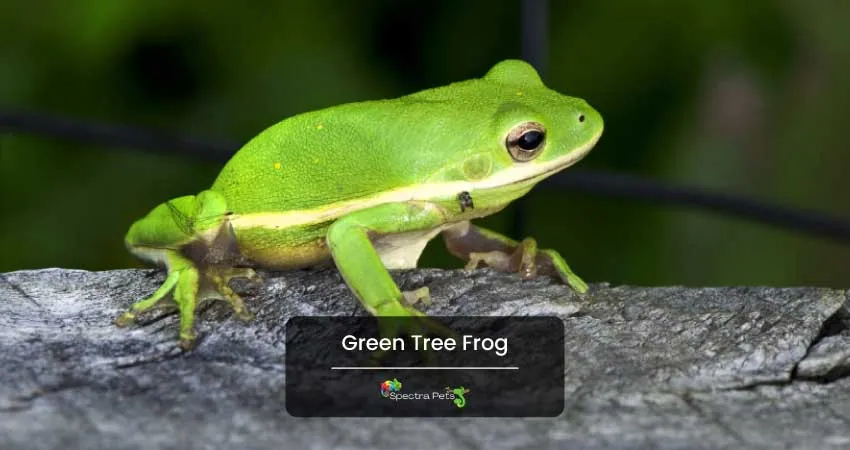
Moreover, the breeding season is both Summer & Spring. And the male calls the female with a nasal hook that repeats 75 times per minute. After listening to the call, females move towards the breeding spot like swamps & permanent shallow water pools. Female frogs would lay 400 eggs on the water’s surface.
In comparison to other tree frogs, they get a long life with an average of 2-5 years. These little fellas get sexual maturity around 2 years. During the daytime, they hide under thick vegetation in moist areas. As soon as the sun goes down, they begin to hunt for food.
Though their large sticky toe pads make them exceptional climbers, they are bad swimmers. The Diet list of this frog is made of cricket, moth, flies, ants, beetles, mosquitoes, etc.
In addition to that, this frog weighs around 3.76 grams. And they are also not poisonous. When it comes to predators, snakes and predatory birds mostly hunt this species.
One of the unique characteristics of this frog is that it can change its skin tone depending on the change of surrounding mood and temperature.
10. Gray tree frog
Gray tree frogs belong to the land of Arkansas and other states like Indiana, Alabama, Ohio, Texas, Minnesota, Vermont, Tennessee, etc.
As far as size is concerned, they are considered the big brother of the Hylidae. These rocky wart-skin creatures can grow around 2-2.5″ in length.
Plus, they are gifted with a color-changing ability which extremely helps them to hide from predators. Whenever they feel any snake, bird of prey, or raccoon around them, their skin color changes to match the background and substrate colors.
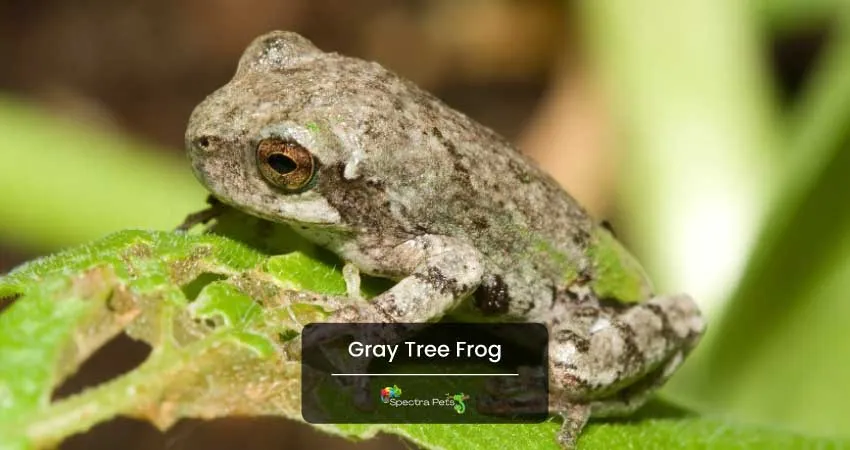
Moreover, they spend a good amount of time on trees. Their sticky toe pads make the climbing effortless.
In addition to that, they can produce toxic through the skin which is an irritating experience for the predator. Right after biting the frog, the hunter will feel a foul taste which results in avoiding the frog. These amphibians also give grave warnings to the predator with their radiant color.
When it comes to choosing habitat, they choose swamps, agricultural land, and moisture-filled woodland as their sweet home. And they pick fishless ponds, swamps, temporary pools, and roadside ditches for their breeding site.
Regarding diet, they consume a big amount of beetles, snails, ants, grasshoppers, plant lice, and moths. They don’t even spare the small frog that crosses their path.
The male tends to show a high level of aggression during the breeding season. Even they will fight with each other over the female & their territory. Usually, the female lays around 2000 eggs a few days after the mating.
Besides, the breeding season of this frog stays from April-August and the male emits loud calls to grab the attention of females. This wonderful creature has an average survival rate of 7-9 years in the wild. And it takes them less than two years to reach sexual maturity.
Furthermore, the dorsal color can be green, gray, or brown. When the night begins, their skin shade becomes lighter, and as the day returns, their skin shade darkens.
11. Cope’s gray tree frog
Cope’s Gray tree frog has a wide range of distribution and can be found in Arkansas, Florida, Indiana, Ohio, and Wisconsin, among other places in the USA. This tough critter has an average 2.5 years lifespan in the wild, and the maximum was found at 7 years old.
One of the ways they keep themselves harmless is by staying under high-level vegetation. As a result, it becomes hard for the predator to track and catch them. The most desirable habitat of this frog is in a woodland area close to water.
Generally, their breeding period starts in April and ends in July. They engage in sexual activity when they reach sexual maturity at 2 years. Humidity plays a crucial role in their mating process. For breeding, the male frogs select sites like puddles, ponds, marshes, roadside ditches, etc.
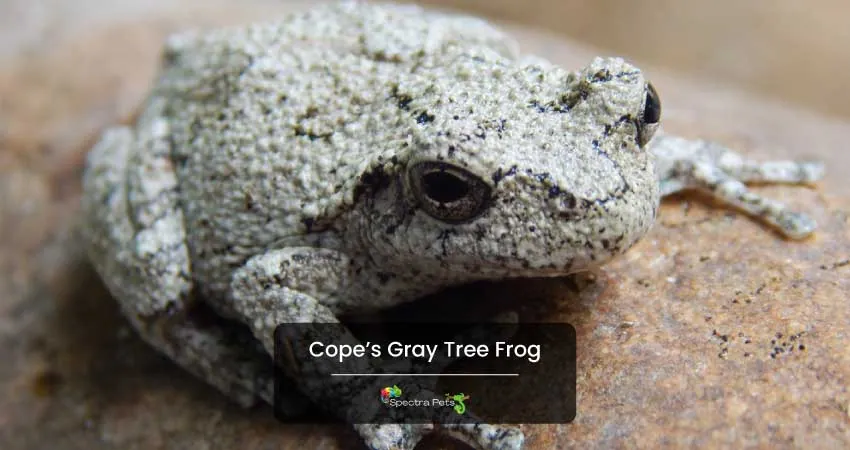
People of Arkansas can encounter these tree frogs hanging around in their backyard in search of food. The dorsal color of this tree frog can be green, brown, or gray.
Plus, they pass the blood-freezing winter without a problem as they switch to hibernating mode. Talking about size, it can vary from 1.25″- 2″. Like many other frogs, the female is bigger.
Moreover, this nocturnal tree frog prefers nighttime for hunting its food. Due to their big population and good reproduction rate, they are listed as the least concerned frog in many states of the USA.
Furthermore, the frog consumes a wide variety of food, including snails, crickets, spiders, mosquitoes, ants, and beetles. While they become food for predators like snakes, raccoons, crayfish, birds of prey, etc.
12. Spring peeper frog
These teeny-tiny amphibians can have brown, reddish, greenish, and tan color skin. This amazing species can handle extreme cold & hot weather.
Every year when freezing winter shows up, they like to spend the entire winter in hibernation. During this time, they sit under tree logs, soft mud, or tree barks.
If they get access to a significant amount of insects like ants, spiders, worms, flies, etc then they can grow up to a maximum of 1.5″. Thankfully, these colorful squishy animals provide excellent benefits to the ecosystem by consuming a large number of insects over the year.
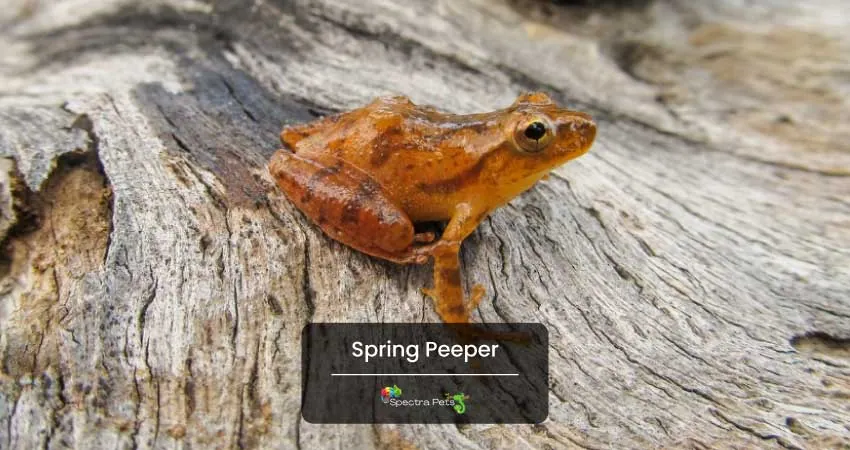
A healthy spring peeper frog usually survives around 2 years of life in its natural habitat. While in urban areas, they survive close to 4 years. Because, in urban sites, the percentage of potential predators is very low. Also, due to their stable survival rate & stable reproduction rate, they are considered the least concerned amphibian.
In addition to that, they go hunting at a fixed time. Usually, the adult frog searches for insects in the late afternoon while the young froglet does it from the morning – the afternoon.
Plus, their 1.5 feet jumping ability help them to evade killers like salamanders, large spiders, snakes, birds of prey, etc.
Usually, their breeding period starts in March and continues until June. The male gives their full effort to allure the female with their peeping sound. In one minute, they repeat the sound at least 20 times. The female feels most attracted to the male that has the loudest voice.
Breeding sites like fishless ponds, roadside ditches, and seasonal pools are their top choice. The mommy frog lays approximately 1200 eggs in a season. These eggs become froglets within the next 3 months.
Finally, for their best growth & body function, they make their home to moisture-trapped areas like grassland or woodland nearby the lakes or swamps.
13. Illinois chorus frog
This chubby tree frog is found in Arkansas, Illinois, and Missouri. They can grow from 1-2″ in body length.
Plus, they can live in a wide variety of natural habitats like sand prairies, flooded fields, marshes, fishless ponds, sandy fields, agricultural land, etc. These expert diggers stay a long time underground at a depth of 6-8 inches.
Moreover, the male emits a bird-like call to attract the female in the breeding season. The skin color of this amphibian can be brown, gray, or tan color. Adding to that, this granular skin little buddy has a white color belly.
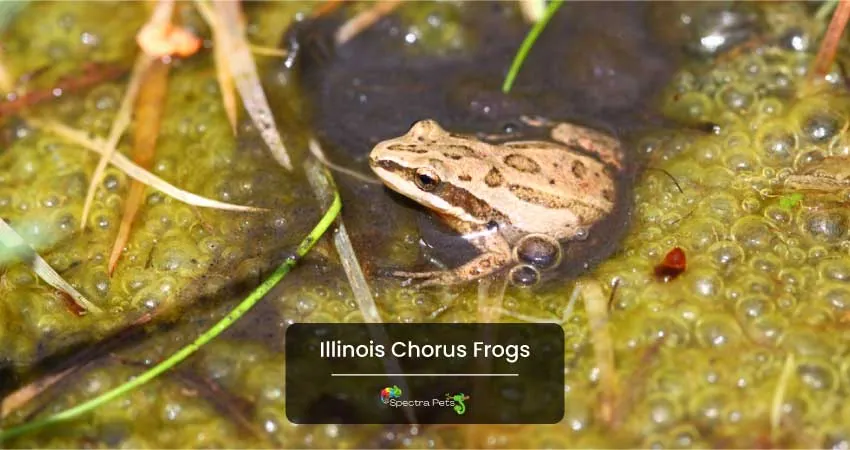
From February – April, they will breed in their breeding sites. Most of the time the mating will happen right after heavy rainfall. After the mating, the female frog lays around 600-700 eggs on the aquatic plants of the breeding spot. Out of all eggs, only 2-7% become froglets and enter the ecosystem.
In terms of prominent body marks, the V mark between the eyes and the spot below the two eyes are prominent. These tiny critters spend their life by eating up a large number of insects in the local ecosystem.
Besides, their lifespan is mostly 2-3 years. However, the highest was recorded up to 6 years in the wild. This frog is listed as a special concern frog in Arkansas due to their habitat loss issue.
Final words
Irrespective of whether you are a native of Arkansas, this article is written to connect the mind of all tree frog lovers & fill the empty space of their minds with updated information found through research.
If you can claim & feel that you have immense knowledge of the tree frogs in Arkansas then the writing would be a worthy one.
Everyone sees the world with a different color hopefully this short post will make your one more colorful.
Tree Frogs Found in the Nearby States of Arkansas:

